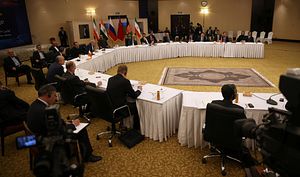With Iran’s convening of its first “Regional Security Dialogue” summit in late September 2018 attended by deputy national security advisors from Russia, China, and India, Tehran has taken a significant step toward creating a multilateral framework for Eurasian security cooperation. In the face of U.S.-led international sanctions, Tehran’s efforts to develop multilateral security cooperation provide the framework by which Asia’s giants can partner with Iran. Despite ostensible devotion to combating terrorism in Afghanistan, the summit’s declaration of points indicates a wide-sweeping stabilization agenda extending from Syria eastward to include all of Central Asia. The participants agreed to formalize the framework and deepen multilateral cooperation by convening an annual summit of national security advisers.
By virtue of its geography and history, Iran requires no “pivot” to Asia. Persian empires, in their various forms from antiquity through medieval times, were quintessential Eurasian powers. Iran’s “Look East” policy under the presidency of Mahmoud Ahmadinejad (2005-2013) sought to embrace the East in the context of crippling sanctions from the West. However, despite robust commercial relations with both Russia and China, Tehran struggled to bring Moscow and Beijing into alignment with its anti-U.S. policy.
Anticipating U.S. President Donald Trump’s withdrawal from the Iran nuclear deal, Iran’s Supreme Leader Ayatollah Ali Khamenei declared in February 2018 a policy of “preferring East to West.” Tehran’s new approach of creating a multilateral framework for collective security cooperation involving Russia, China, and India seems to be proving far more successful than previous efforts.
For Russia, China, and India, each of which respectively faces threats of low-intensity conflict from various local and transnational Sunni extremist groups, Shiite-dominated Iran is also viewed as a natural partner in combating terrorism. However, point nine of the Regional Security Dialogue’s closing declaration reveals competition over the emerging architecture of Eurasian commercial connectivity to be the overarching impetus for multilateral security cooperation. Point nine defines “one of the objectives” of such cooperation to be “economic and commercial development” involving “establishing secure transit routes using existing infrastructure as well as creating new infrastructures.”
For Beijing’s massive Eurasian commercial route, the Belt and Road Initiative (BRI), Iran provides a crucial link for a China-Europe rail that does not traverse Russian territory. China’s currently planned route utilizes the Baku-Tbilisi-Kars railway and requires ferrying cargo across the Caspian Sea from Central Asia to Azerbaijan. An Iranian rail link would offer a contiguous and more cost-effective efficient. Using Iran’s north-south rail links, it could create a vital vertical axis connecting China’s main East-West Corridor to the Middle East and the Arabian Sea.
Beijing has already been creating a similar north-south vertical axis with its $46 billion China-Pakistan Economic Corridor (CPEC) that would connect the Chinese-built, deep-sea port in Gwadar, Pakistan to Kashgar in China’s restive Xinjiang province. In contrast to CPEC, a China-Iran Corridor offers the added benefit of direct overland connections with the Middle East while facing fewer security and engineering challenges. Beijing’s CPEC runs through Pakistan’s Khyber Pakhtunkhwa province, historically the stronghold of Taliban militancy, and Balochistan, home to ethnonationalist unrest. Moreover, rail construction needs to cross the formidable Karakoram Mountains. In contrast, the China-Iran corridor would not traverse such a dangerous security environment and would simply involve the upgrading present rail links to high-speed rail with uniform, standard gauge tracks.
During January and February 2016, the first China-Iran cargo train made its maiden journey from China’s eastern Zhejiang province, south of Shanghai, to Iran in just 14 days, beating the time of the maritime route from Shanghai to Bandar Abbas by two-thirds. Replacing Soviet-era non-standard gauge tracks in Central Asia with high-speed rail would likely reduce travel time even further.
Likewise, India regards Iran as the critical transit link for creating a commercial transit corridor for Indian Ocean-Europe trade. While Iran and India traditionally have been allies in Afghanistan against Pakistan, New Delhi’s drive to construct a deep-sea port at the Iranian city of Chabahar, along with commercial transportation corridors running northward, has been motivated by its economic rivalry with Beijing. India’s answer to China’s BRI is New Delhi’s International North-South Transit Corridor (INSTC) initiative. With India’s overland access to Central Asia is blocked by Pakistan, the Chabahar deep-sea port and the INSTC running northward through Iran and Afghanistan will provide New Delhi vital access to Central Asian, Russian, and ultimately European markets, enabling India to effectively compete with China. The Chabahar port, 72 kilometers west of the Chinese-built port at Gwadar, Pakistan, will serve as the Indian Ocean outlet for the INSTC, which is estimated to be 30 percent more cost effective than the traditional maritime route via the Red Sea, Suez Canal, and the Mediterranean Sea.
Russia shares similar interests in a north-south corridor with India; however, its most immediate concern is to secure Moscow’s influence over the South Caucasus and Caspian Sea Basin. The success of Turkey’s energy and transportation partnership with Azerbaijan has enabled Ankara to expand its influence in the South Caucasus and extend it further into Turkmenistan and the other Central Asian republics. The potential expansion of Ankara’s influence among the Turkic peoples of the South Caucasus and Central Asia, as well as within the territorial borders of Russia and China, presents an enduring challenge for Russia as well as China.
In the competition for influence in the southern rim of the Eurasian landmass, the area encompassing the Middle East and the Caucasus, Iran is an indispensable partner for Russia, China, and India. Tehran’s efforts have laid the foundation for deepening multilateral security cooperation with Moscow, Beijing, and New Delhi.
Dr. Micha’el Tanchum is a Fellow at the Truman Research Institute for the Advancement of Peace, Hebrew University and an affiliated scholar with the Centre for Strategic Studies at Başkent University in Ankara, Turkey (Başkent-SAM). Follow @michaeltanchum

































